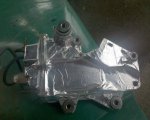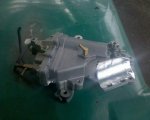rib4charter
Cadet
- Joined
- Jun 3, 2008
- Messages
- 26
So My boat has been in both freshwater and saltwater. I also had the tanks pumped out, and then the vst filter cleaned, then the problem still happened after e10 added where I get this buildup that looks like sand. I think the challenge is that there are microscopic particle of sodium sulfate in the ethanol from the manufacturing process, shipping, and storage. I am also wondering if they use salts to reduce moisture in the fuels. What is happening from what I am reading online is that the VST tank being aluminum is mounted next to the engine block and this takes on a treemensous amount of heat that goes into the VST Tank. The article from the link below says this:
http://www.txideafarm.com/ethanol_fuel_properties_and_data.pdf
The second most important property is "volatility". This is customarily measured by RVP, but latent heat and boiling point or initial boiling range play important roles. During cold start, there must be sufficient fuel actually vaporized during the compression for there to be a flammable mixture for the spark plug to ignite.
RVP is measured at 100 F, for which ethanol?s RVP of 2 psi already "looks low". If this pressure were measured at colder temperatures, the ethanol vapor shortfall looks even worse: there is very little sensible evaporation going on below about 50 F. The higher latent heat of evaporation compounds this effect. That?s why a little gasoline in the blend is beneficial to cold start, or else one must use a start canister of something flammable and volatile, like gasoline, to prime the engine for starting.
I wonder if the ethanol is evaporating in the VST tank due to the high heat levels and this is releasing the micro deposits trapped in the fuel (which are getting by a 2 micron filter) which then get stuck on the VST filter screan. Think of it as boiling water. If you boil all the water out of a pot, you get salt deposits left at the bottom. The VST Tank gets to hot for the ethanol blend. The more ethanol % you have the worse it gets. The more water the ethanol has trapped in the, the worse it gets. If you have no ethanol, no water gets absorbed. The problem is that the startron fuel stabailizer may allow the "water" to pass from the fuel tank, to the vst tank, and when the ethanol vaporizes, the salts in the water get released, thus causing the deposits. Most people have said that it is sodium sulfate that is in the bottow of the vst filters. You wonder if you need some sort of heat shield on the vst tank. Or a VST tank that can handle ethanol and be an insulator.
Any thoughts Rodbolt????
http://www.txideafarm.com/ethanol_fuel_properties_and_data.pdf
The second most important property is "volatility". This is customarily measured by RVP, but latent heat and boiling point or initial boiling range play important roles. During cold start, there must be sufficient fuel actually vaporized during the compression for there to be a flammable mixture for the spark plug to ignite.
RVP is measured at 100 F, for which ethanol?s RVP of 2 psi already "looks low". If this pressure were measured at colder temperatures, the ethanol vapor shortfall looks even worse: there is very little sensible evaporation going on below about 50 F. The higher latent heat of evaporation compounds this effect. That?s why a little gasoline in the blend is beneficial to cold start, or else one must use a start canister of something flammable and volatile, like gasoline, to prime the engine for starting.
I wonder if the ethanol is evaporating in the VST tank due to the high heat levels and this is releasing the micro deposits trapped in the fuel (which are getting by a 2 micron filter) which then get stuck on the VST filter screan. Think of it as boiling water. If you boil all the water out of a pot, you get salt deposits left at the bottom. The VST Tank gets to hot for the ethanol blend. The more ethanol % you have the worse it gets. The more water the ethanol has trapped in the, the worse it gets. If you have no ethanol, no water gets absorbed. The problem is that the startron fuel stabailizer may allow the "water" to pass from the fuel tank, to the vst tank, and when the ethanol vaporizes, the salts in the water get released, thus causing the deposits. Most people have said that it is sodium sulfate that is in the bottow of the vst filters. You wonder if you need some sort of heat shield on the vst tank. Or a VST tank that can handle ethanol and be an insulator.
Any thoughts Rodbolt????





















